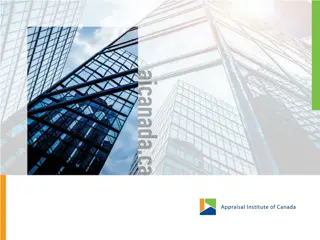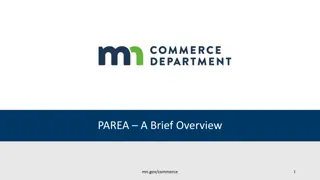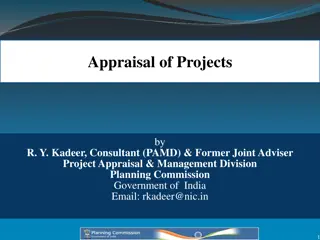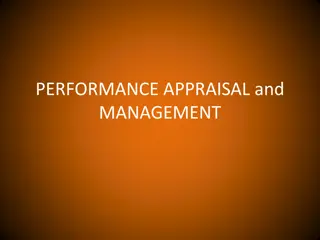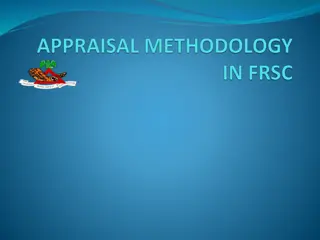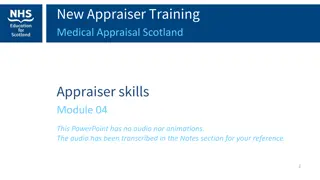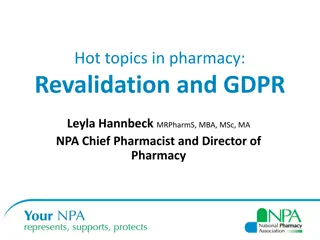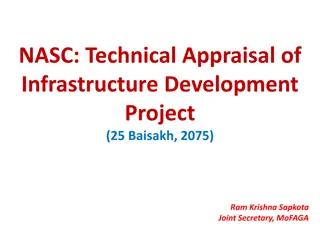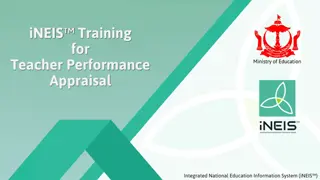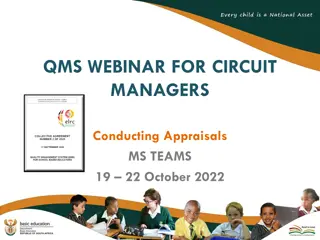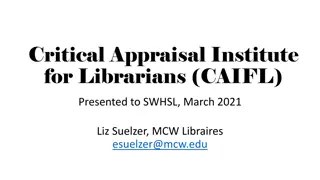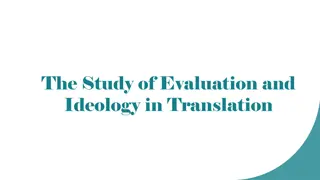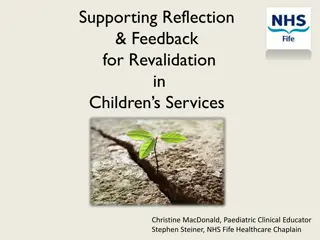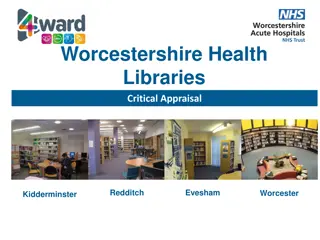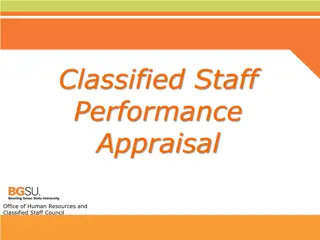Educational Appraisal in Medical Education: Importance, Requirements, and Revalidation
Explore the significance of educational appraisal in medical education, its requirements based on professional standards for medical educators, and the revalidation process for Clinical and Educational Supervisors. Discover the seven domains of educational appraisal, examples of evidence, and the essential role it plays in supporting trainees, departments, and ultimately patients.
Download Presentation

Please find below an Image/Link to download the presentation.
The content on the website is provided AS IS for your information and personal use only. It may not be sold, licensed, or shared on other websites without obtaining consent from the author.If you encounter any issues during the download, it is possible that the publisher has removed the file from their server.
You are allowed to download the files provided on this website for personal or commercial use, subject to the condition that they are used lawfully. All files are the property of their respective owners.
The content on the website is provided AS IS for your information and personal use only. It may not be sold, licensed, or shared on other websites without obtaining consent from the author.
E N D
Presentation Transcript
Educational Appraisal Dr Caz Farrow School of Anaesthesia Conference November 2020
Overview Importance of & requirements for educational appraisal 7 Domains Nature of each domain & examples of evidence Opportunities & challenges
Why is this important? Annual appraisal should reflect the entirety of scope of practice with supporting info For ES/CSs, educational appraisal occurs as part of the general appraisal process ES: A trainer who is trained to be responsible for the overall supervision & management of a specified trainee s educational progress CS: A trainer who is appropriately trained to be responsible for overseeing a specified trainee s clinical work Educational appraisal helpful tool to develop individual, to benefit of trainees, department & ultimately patients
What is required? Professional standards for medical educators incorporated into GMC s Promoting excellence 7 standards provide the formal framework for EA: 1. Ensuring safe & effective patient care 2. Establishing & maintaining a safe environment for learning 3. Teaching & facilitating learning 4. Enhancing learning through assessment 5. Supporting & monitoring educational progress 6. Guiding personal & professional development 7. Continuing professional development (CPD) as an educator
Revalidation CS/ESs subject to revalidation as educators To retain ES/CS status need to (as a minimum): 1. Present one piece of evidence demonstrating CPD as an educator EACH YEAR (domain 7) 2. Present evidence of CPD against each of domains 1-4 (CS) or 1-6 (ES) over revalidation cycle 3. Present at least 3 different types of evidence over the 5- year cycle
What is evidence? A piece of evidence can demonstrate development in more than one domain CPD Feedback Generic evidence eg GMC Survey (Trainee & trainer) - elements of both refer to many domains Reflection must be combined with evidence to drive learning & development Next slides explain the seven domains with examples of evidence
1) Ensuring safe & effective patient care through training Courses attended on supervision, learning or teaching Measures put in place to ensure appropriate supervision eg Rota consultant, exception reports, COVID-rota design Involvement of trainee in QI projects eg QI work supervised, trainee audits Support provided for trainees involved in critical incident analysis Design/participation of induction programmes eg Induction Lead, MTI Lead Departmental training plans including sharing info between trainers
2) Establishing & maintaining an environment for learning Courses attended on supervision, learning or teaching Details of learning opportunities provided for trainees eg courses Trainee feedback Feedback from MDT colleagues
3) Teaching & facilitating learning Participation in teaching programmes E-portfolio activity for trainees Initiatives to enhance teaching & training eg Introducing Education Checklist, RSI sim sessions, RCoA curriculum feedback Promotion of teaching & training Observed teaching & feedback eg sim debrief with peer feedback
4) Enhancing learning through assessment Understanding of LLP/e-portfolio & WBPAs ARCP attendance Involvement in exams eg OSCEs, question writing, observe RCoA exams
5) Supporting & monitoring educational progress Anonymised records of trainee progress eg ESSR, ARCP outcome/attendance Involvement in recruiting, training committees Participation in recruitment eg CT/ST interviews Trainee feedback Mentoring/coaching
6) Guiding personal & professional development Anonymised examples of support, career advice provided Anonymised examples of trainee meetings, managing trainees in difficulty Mentoring/coaching
7) CPD as an educator Easiest section to evidence Balance of learning activities & experiences, with reflection Evidence in this section likely relates to other domains Courses relating to training & education Medical education qualifications gained Feedback on teaching Awards/commendations
CPD suggestions Generic & anaesthetic specific Local Regional: School Conference, Train the Trainers, other HEYH National: RCoA Anaesthetists as Educators, SEAUK ASM, GIC, ASPiH, AAGBI mentoring programme Online courses eg E-learning LTFT Online resources: SEAUK, HEYH er SuppoRTT, webinars
What next? Further aspects of appraisal: 1. What are areas of strength & weakness & what can be done to help build on former/advance latter? 2. What are the plans for remainder of revalidation cycle & how can this be achieved? Incorporate into overall PDP
Challenges Time Multiple areas of discussion



